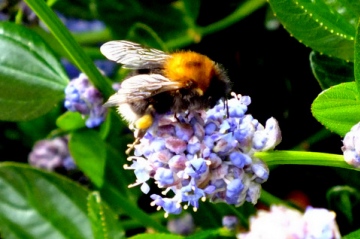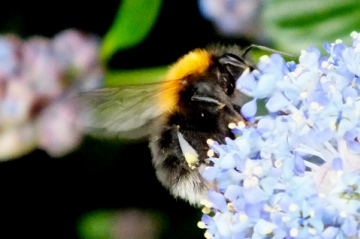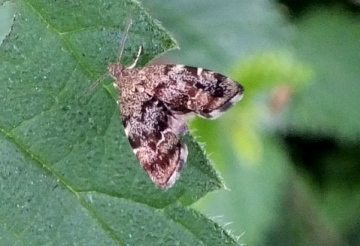Like Graham we have the Tree, New Garden Bumblebee, Bombus hypnorum in the garden. Yesterday there were upwards of 25 on our ceanothus shrub at any one time, unlike his though, ours are not resident in the garden but appear to be from two nests. Observing their flight paths, one is to the east in the Magdalen Wood area the second, south along the back gardens towards Colchester.


They are extremely active compared to the lumbering White and Red-tails, scurrying around on the flower heads at a terrific pace making photography nigh-on impossible, plenty of flower heads with not a bee in sight or just blurred images. They are also aggressively inquisitive coming right up to the camera and face, buzzing in quite an intimidating manner, whereas the Whites and Reds continue about their business and take no notice. Also noted are Common Carders, Buff-Tails, and one that I cannot identify having a fluffy grey thorax with a black and grey striped abdomen.
Honey bees are very scarce with only the odd one or two in our shrubs and flowers. This may be, in some part, due to our neighbours who recently had a chimney removed, one less for the Jackdaws to build in. Before they started work saw what seemed to be white smoke issuing from the roof tiles around the chimney. Fearing a fire I got the bino’s out to investigate, only to see a swarm of bees on the tiles and realised what was happening. Soon after several bees arrived in the garden with white powder on them and died. The chimney was removed soon after.
A recent search of the Mistley Walls/Mistley Place Park area for ladybirds was absolutely fruitless. All that we found were three, 14-Spots in the reeds along the river. Given the thousands there had been the winter before last it was quite a disappointing result. Pine ladybirds were not seen, but here again the trees in which they are normally found are devoid of scale insects which appeared to be their attraction to the area. We did however find three Nettle Taps on a nettle bed near Mistley Towers.

Looking at the NBN map it does show this moth as present along the Stour valley but not very prevalent in north Essex. Is this a comparatively uncommon moth or is it just a lack of records?


They are extremely active compared to the lumbering White and Red-tails, scurrying around on the flower heads at a terrific pace making photography nigh-on impossible, plenty of flower heads with not a bee in sight or just blurred images. They are also aggressively inquisitive coming right up to the camera and face, buzzing in quite an intimidating manner, whereas the Whites and Reds continue about their business and take no notice. Also noted are Common Carders, Buff-Tails, and one that I cannot identify having a fluffy grey thorax with a black and grey striped abdomen.
Honey bees are very scarce with only the odd one or two in our shrubs and flowers. This may be, in some part, due to our neighbours who recently had a chimney removed, one less for the Jackdaws to build in. Before they started work saw what seemed to be white smoke issuing from the roof tiles around the chimney. Fearing a fire I got the bino’s out to investigate, only to see a swarm of bees on the tiles and realised what was happening. Soon after several bees arrived in the garden with white powder on them and died. The chimney was removed soon after.
A recent search of the Mistley Walls/Mistley Place Park area for ladybirds was absolutely fruitless. All that we found were three, 14-Spots in the reeds along the river. Given the thousands there had been the winter before last it was quite a disappointing result. Pine ladybirds were not seen, but here again the trees in which they are normally found are devoid of scale insects which appeared to be their attraction to the area. We did however find three Nettle Taps on a nettle bed near Mistley Towers.

Looking at the NBN map it does show this moth as present along the Stour valley but not very prevalent in north Essex. Is this a comparatively uncommon moth or is it just a lack of records?


















